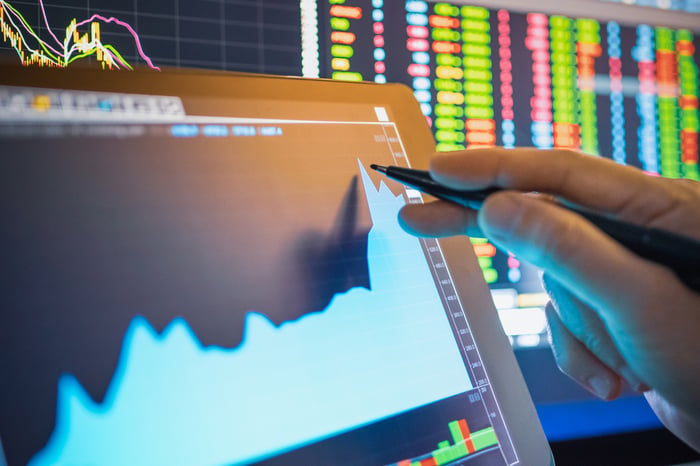Patience has paid off handsomely for growth stock investors since the end of the Great Recession. With interest rates near historic lows and the nation's central bank maintaining a dovish monetary policy for much of the past 12-plus years, the benchmark S&P 500 has gained 561% since hitting its Great Recession low in March 2009.
But these mammoth gains for the S&P 500 wouldn't be possible without the outperformance of the FAANG stocks.

Image source: Getty Images.
When I say "FAANG," I'm referring to:
- Facebook (META -1.08%)
- Apple (AAPL 0.51%)
- Amazon (AMZN -1.41%)
- Netflix (NFLX -0.70%)
- Google, which is now a subsidiary of Alphabet (GOOGL 0.49%) (GOOG 0.38%)
If you think the S&P 500's 561% gain is impressive since March 2009, take a gander at how the FAANG stocks have rewarded their shareholders over the same period:
- Facebook: Up 854% (since its IPO in May 2012)
- Apple: Up 4,777%
- Amazon: Up 5,536%
- Netflix: Up 11,323%
- Alphabet: Up 1,842% (Class A shares, GOOGL)
Streaming provider Netflix has provided five-digit gains, while Apple, Amazon, and Alphabet have lapped the broad-based S&P 500 many times over. Even Facebook has outperformed the S&P 500 in three fewer years.
Yet even with these monstrous gains, select Wall Street analysts still see ample upside in three FAANG stocks. Based on the highest price target estimate from analysts or Wall Street investment banks, the following trio of FAANGs offer 47% to as much as 55% upside over the next 12 months.

Image source: Amazon.
Amazon: Implied upside of 47%
The first FAANG stock expected to deliver big gains over the next year is e-commerce giant Amazon. According to investment bank Susquehanna, Amazon is slated to hit $5,000 a share, which would represent an implied gain of 47%, relative to where it closed this past weekend.
What makes Amazon such a special company is its complete dominance in two major trends. First, as most folks probably know, Amazon is the kingpin of online retail sales in the United States. In August, a report from eMarketer estimated that Amazon would bring in 41.4% of all U.S. online retail spending in 2021. That's more than 34 percentage points higher than the No. 2 company in market share, Walmart.
But the key to Amazon's retail success is its subscriber service, Prime. As of earlier this year, Amazon hit 200 million Prime subscribers. While these folks enjoy a number of perks, such as free two-day shipping, Amazon enjoys binging in tens of billions of dollars in high-margin revenue that helps to offset the razor-thin margins tied to online retail. This fee-based revenue also helps the company undercut brick-and-mortar retailers on price.
The second trend where Amazon dominates is cloud infrastructure services. According to Canalys, Amazon Web Services (AWS) brought in 31% of the $47 billion in cloud infrastructure spending in the second quarter, with AWS on track for more than $59 billion in annual run rate sales. Considering that more businesses than ever are establishing an online and cloud-based presence in the wake of the pandemic, AWS still looks to be in the early innings of its growth.
More importantly, the fastest-growing segments for Amazon are generating the best margins. AWS, subscriptions, and advertising have shown no signs of slowing, and they should play a big role in growing the company's operating cash flow through the midpoint of the decade.
A $5,000 price target within 12 months isn't out of the question considering Amazon's dominance and cash flow growth.

Image source: Getty Images.
Facebook: Implied upside of 54%
Another FAANG stock that could show investors some serious green over the coming 12 months is social media behemoth Facebook. Credit Suisse analyst Stephen Ju represents the high-water mark on Wall Street, with a call for shares to head to $500.
Ju and other Facebook enthusiasts likely recognize the company's social media lure. In the June-ended quarter, Facebook attracted 2.9 billion monthly users, with another 610 million unique users visiting Instagram or WhatsApp each month (Facebook owns these sites, too). All told, that's 3.51 billion monthly active users. If we were to remove children too young to use social media websites, we'd be talking about more than half of the world's adult population logging onto a Facebook-owned asset each month. That's a powerful figure not lost on advertisers, and it's why the company has significant ad pricing power.
Arguably the most jaw-dropping thing about Facebook is that it's on pace for well over $100 billion in advertising revenue this year, yet it's only seriously monetizing two its four core assets (Facebook and Instagram). When the company does open the floodgates on Facebook Messenger and WhatsApp, it'll experience another surge in sales and cash flow.
Investors might also be overlooking the long-term potential of Facebook's ancillary aspirations. It aims to be a leader in virtual reality with its Oculus devices, and hasn't given up on the idea of becoming a payments hub with a blockchain-based crypto project.
Taking into account its recent PR issues, Facebook hitting $500 in the near-term might be a stretch. However, the company remains fundamentally cheap (a forward price-to-earnings ratio of 20) considering its steady 20%-plus sales growth rate, making it a clear bargain among the FAANGs.

Image source: Getty Images.
Netflix: Implied upside of 55%
Interestingly enough, the FAANG stock with the highest perceived upside happens to be the one that's had the biggest run since the Great Recession, Netflix. Among the more than three dozen analysts covering Netflix, the Street-high price target of $971 implies gains of up to 55% over the coming year.
The optimism surrounding Netflix has to do with its leading streaming subscription service. Through the midpoint of 2021, it had more than 209 million paying streaming members worldwide. Between the depth of its content library and the dozens of proprietary shows the company has created, Netflix holds substantial pricing power on its subscribers and has had little issue passing along price hikes when necessary.
Also working in Netflix's favor is America's distaste for traditional cable and satellite services. A report from NScreenMedia in May 2021 showed that more than 21 million fewer households now have traditional cable, satellite, or TelcoTV in their homes, compared to four years ago. In many instances, these households are choosing to go with streaming providers that give them more choice and a substantially lower monthly bill.
However, Netflix's long-term growth thesis isn't as clear as the other FAANGs. While it's been able to put skeptics in their place for more than a decade, streaming competition is only increasing. In particular, Walt Disney's streaming service, Disney+, reached 116 million subscribers in early July. It's taken Disney less than two years to reach this figure, whereas it took Netflix a decade to surpass 200 million global subscribers.
The other concern with Netflix is that it's historically been a company that burns through its cash on hand. While its cash burn looks to finally be in the rearview mirror, Netflix is already valued at well over 200 times Wall Street's estimated operating cash flow per share in 2021. If Netflix were to somehow reach $971 a share, it would take until 2024 before its cash flow per share multiple dipped below 100.
Netflix appears to be priced for perfection, which makes a $971 price target within 12 months highly unlikely, in my view.





